Exclusive Interview with the winner of Sky Arts Landscape Artist of the Year 2018
Posted by Cass Art on 1st Feb 2019
After being treated for so many weeks to beautiful paintings, wonderful landscapes and fascinating artists we have our winner! Read our exclusive interview below where we catch up with winner Jen Gash and find out all about her experience of winning Sky Arts Landscape Artist of the Year 2018, the £10,000 commision to paint a work marking the centenary of The First World War Armistice for the Imperial War Museum and also £500 of materials from Cass Art.
The final must have been quite some experience! What was going through your mind when you looked down across London at Greenwich Park?
I was completely overwhelmed and daunted by the view from the pods at Greenwich observatory. It was my worst nightmare – I like city scapes, but not the whole of London! I was also a little discombobulated by my family and friends being there. For the previous rounds I had been on my own and I think I like the solitude and focus that brings, so I had to find another way to get space. It was as if there was a visually overwhelming view in front of me and an emotionally overwhelming one behind me in the form of my family. I was convinced at this point, that I didn’t have a chance but told myself that I had done so well to get to the final that it didn’t really matter! It was also so very cold, compared to the previous rounds and my sandaled feet and thin shirt were fairly inadequate.
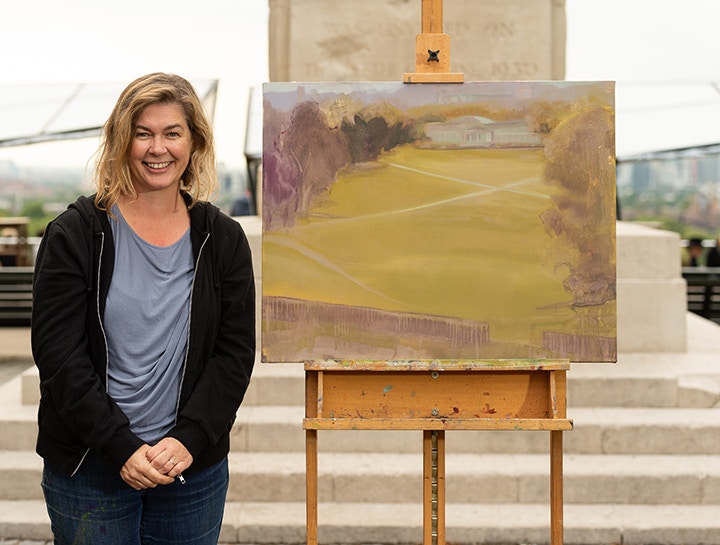
Jen Gash with her winning painting of Greenwich Park
Did you give yourself a small pep talk before you picked up your brushes?
Yes. For each round I had written myself a sheet which acted as prompt for me and to help me focus and think straight. I am framing that piece of paper as we speak! In fact I had to give myself a good talking to at various points in the day including lunchtime when I took myself for a walk and hid in the bushes down the hill...my family thought I had done a bunk but I just needed some quiet head space. Whilst I love the cameras and the presenters and judges, it was so full on in the final that I got to mid-day and felt I had done so very little and I was starting to panic.
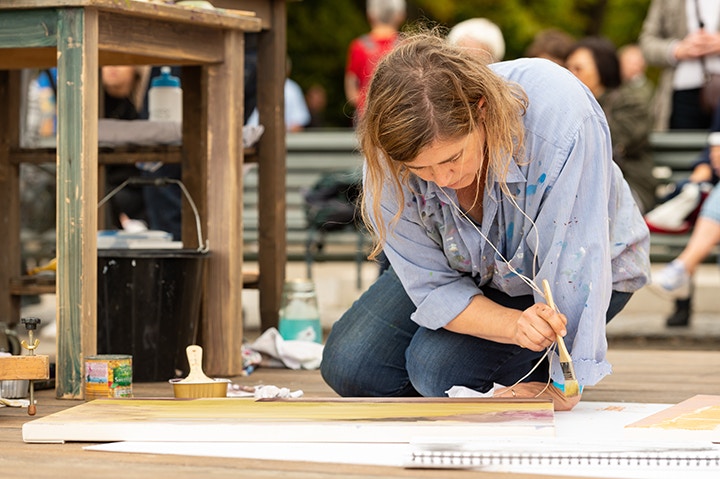
Your winning painting is another delightful example of your use of colour washes, and also your ability to leave areas relatively ‘unfinished’ as it were, for example in the trees and building. Others might be tempted to delve back into and keep working on a painting – does it take a lot of strength to know when to stop?
I truly believe that a painting's value should no way be inferred by the amount of time spent on it. Many famous artists painted stunning work in a couple of hours, work which we consider to be master pieces, so I have learnt to take my time and not fall into overworking. And I rarely enjoy heavily worked paintings by others, unless the working is purposefully in service of the image or process – there is quite a difference. This time overworking was not an option as I was so behind the other two finalists at lunchtime, I had to work to catch up. I also wanted the crossed paths to be a focus in the painting and not get lost in details. Mind you, if you look carefully I have included the Cutty Sark and the Gherkin.
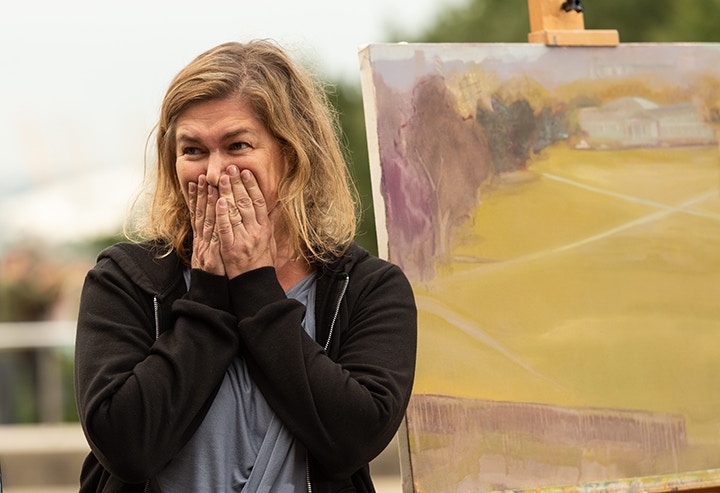
Your commission brief was to create a piece that marked the centenary of The First World War Armistice – was it a daunting proposition for you?
When Joan Bakewell first told me, I was in such shock that I had won, that the prize didn’t sink in for days. Then yes, it was daunting for a while but this quickly gave way to absolute delight, excitement and a real connection with the proposal. I couldn’t wait to meet the head of Art at the IWM and hear more about the commission.
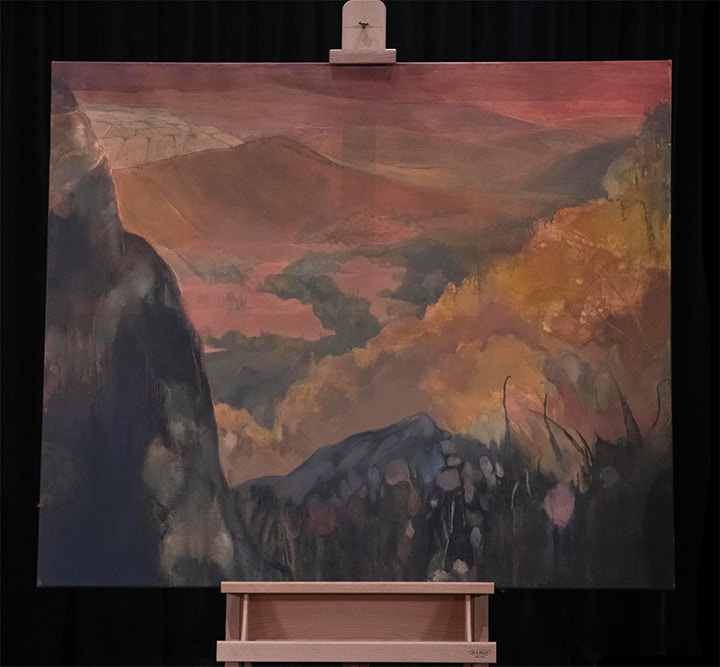
You brought this aesthetic through to your £10,000 winner’s commission, with sweeping washed areas of red and yellow hues – could you talk us through the process?
Well it was quite an immense process to be honest. I came back from Macedonia with many, many ideas and had to be very strict with myself, not to take on too much – I failed! I actually started around 7 paintings and have now completed 4 in addition to the studies I carried out in the field. Something I should say is that I was careful not to indulge myself too much at the expense of creating a piece of work that the majority of people could relate to and understand, hence the main piece was clearly a landscape view.
The last day we went to the battle site. The view across Kosturino ridge was stunning, but very green and in some ways flat so I worked to create shape and a sense of story in terms of the colours. The reds came about in an intuitive way from the triptych study I created on site. I was in a bit of a mood and whacked on some bright, dark red, working in to it quickly. When I came back to the studio, I decided to stick with the red as there were many ways it could be read in light of the historical matters. The painting features commonly seen, native foliage of the region. It also features the rocks of Rocky Peak, the site of a disastrous battle for the allies and in particular, Irish fusiliers. I chose the largest size I felt I could complete in the time scale, which was only around 3 weeks, bearing in mind that the famous war artists often had years to complete their work. I stretch my own canvas and size it before underpainting in acrylic and working over in oil.
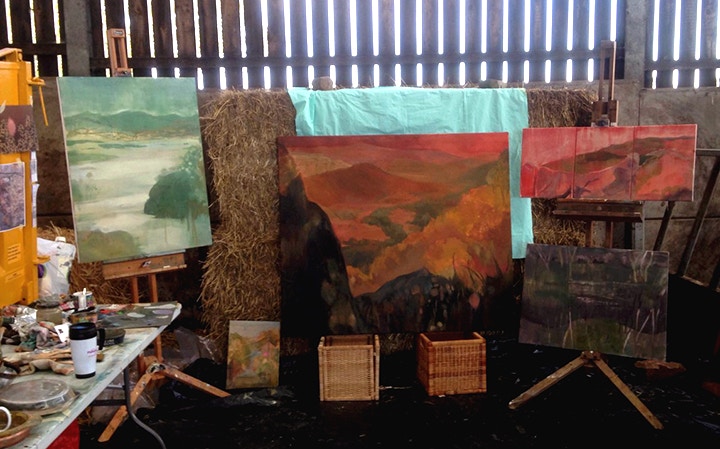
Can you tell us about the experience following in the artist Stanley Spencer’s footsteps to Greece and Macedonia?
There were so many lovely connections with Spencer. Years ago my school art teacher said of my early work that it reminded him of Stanley Spencer’s work and over the years I have enjoyed Spencer’s muted colours and spiritual side to his work. At the Sandham chapel, I was entranced by the murals and other connections occurred to me. Spencer was part of the Medical Corps and I went to school in an old medical corps school in Kent. Spencer was trained at Bristol in the same building at Glenside where I sometimes teach OT. It was all getting a bit weird but I really started to feel like I knew Spencer somehow. I read as much as I could about his work and life and was delighted to meet his family.
The other strange thing that happened, was that the day I started work on the commission I realised that my studio was too small and I had to find an alternative studio space. A local farmer friend said I could use his cow shed and I completed the paintings there. I loved it actually – the space and quietness and cows! It was only when I spoke to one of the directors that she told me that Stanley Spencer had to move his studio into a cow shed to complete his famous war painting “Travoys”. Beyond weird, but I certainly felt a strong connection with Spencer in many ways. The whole process was just amazing – life changing to be honest.
CALL FOR ENTRIES
Inspired by the show? Sky Arts is once again on the hunt for the next Artist of the Year. Whether you're a master of portraiture or a pro at plein air, submit your works for a chance to win a £10,000 commission and £500 worth of art materials from Cass Art. Entries for Sky Arts Landscape Artist of the Year 2020 open on Wednesday 16th October 2019 and close on 17th April 2020. Entries for Sky Arts Portrait Artist of the Year 2021 open on Wednesday 16th October 2019 and close on 7th february 2020. Find out more here.



